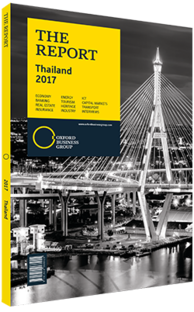Domestic economic boosters are returning to the markets
The Thai equity market is one of the most developed and liquid capital markets in Asia. In 2016 the Thai stock market had share turnover velocity of 62%, the highest among the ASEAN 5 (Thailand, Singapore, Malaysia, Indonesia and the Philippines) and the second largest in terms of market capitalisation after Singapore at $437bn, or 117% of GDP. Supported by regulator policies to enhance the capital market, the Stock Exchange of Thailand (SET) has grown rapidly over the past decade, as evidenced by the number of listed companies increasing by 28% to 656 at the end of 2016, compared to 513 companies in 2006. Meanwhile, market capitalisation has more than tripled during this period.
In terms of performance, along with rising global equity, the SET Index offered an impressive total return of 22.8% in 2016, comprising 19.8% capital gains and 3% dividend yields. The index was largely supported by external factors, including further monetary easing from the Bank of Japan and European Central Bank at the start of 2016 and a significant rebound in commodities prices. Moreover, the domestic economy showed signs of recovery on the back of government spending and private consumption, while exports beat market expectations with slight growth of 0.5%. With all of these positive external and internal developments, the SET saw net positive foreign fund inflow for the first time in the last four years, showing a net inflow of BT77.9bn ($2.2bn) 2016, up from total outflow of BT384.8bn ($10.8bn) from 2013 to 2015.
Projection
In 2017 the SET should have somewhat resilient momentum, despite increasing uncertainty regarding external factors, with the year-end target for the SET Index estimated at 1590 points, based on an 8% discount from bottom-up fair prices. Key drivers are largely anticipated to come from domestic factors, including a solid economic recovery and political stability. The Thai economy started 2017 on a strong note, as fiscal spending, the main engine of growth, still expanded well in January, with most investment focusing on transport and internet development. Exports showed robust expansion in January at 8.5% year-on-year (y-o-y), while the total number of inbound foreign tourists increased 6.5% y-o-y to 3.2m.
Sectors seen to benefit from domestic expansion include construction and materials, tourism and media. Tourism is expected to see a solid recovery from the downturn at the end of 2016 due to heavy flooding in the southern region and the zero-dollar tour crackdown policy. Total foreign tourists are set to reach 35m, a 7.4% increase. Another recommended sector is media, particularly digital TV. Overall ad spending is expected to grow by at least 20-30% during the FY 2016/17 on the back of strong growth in private consumption. New digital TV should see the most benefit on the continuous rising trend in audiences and ratings for these channels. Moreover, the National Broadcasting and Television Commission’s second phase of set-top box coupon distribution from January 31 to March 1 should be another supportive factor for this sector.
Risks
Yet, risks and headwinds from external factors have seemed to increase. There is growing concern over rising inflation, especially in the US, which should urge its Federal Reserve to increase interest rate sooner than the market previously expected. Lower monetary easing policies from major central banks could adversely affect global liquidity and asset prices. Another emerging uncertainty is political issues in Europe as many countries are scheduled to hold elections in 2017, and eurosceptic parties are gaining in popularity.
However, the Thai financial market has more resistance to external shocks than in the past as reflected by Thailand’s international reserves of $172bn at the end of 2016, compared to $87bn and $35bn in 2007 and 1999, the years before the Asian and US financial crisis, respectively. Meanwhile, the equity market is less vulnerable to fund outflow as domestic investors make up a higher proportion, with their average daily turnover having increased from 66% in 2006 to 74% in 2016.
You have reached the limit of premium articles you can view for free.
Choose from the options below to purchase print or digital editions of our Reports. You can also purchase a website subscription giving you unlimited access to all of our Reports online for 12 months.
If you have already purchased this Report or have a website subscription, please login to continue.

